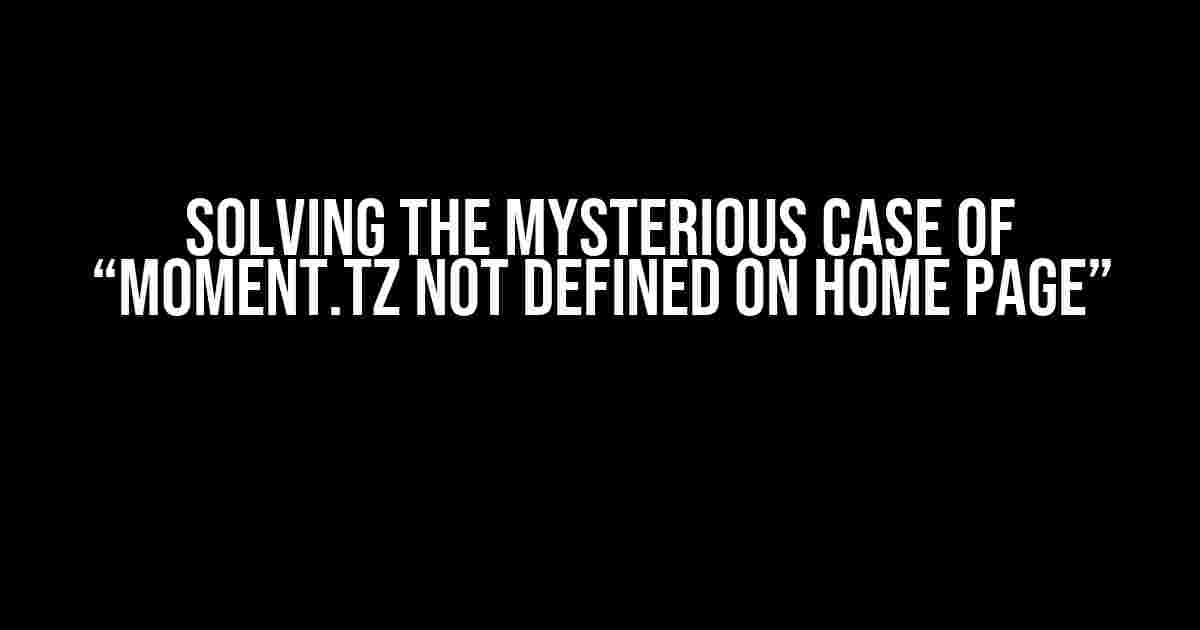If you’re reading this, chances are you’re stuck with an error that’s got you stumped: “moment.tz not defined on home page”. Don’t worry, we’ve got you covered! In this article, we’ll dive into the world of Moment.js, time zones, and JavaScript to help you troubleshoot and fix this pesky issue.
What is Moment.js?
Moment.js is a popular JavaScript library used for parsing, validating, and manipulating dates and times in JavaScript. It provides a simple and intuitive way to work with dates, including support for time zones. But, like any library, it can be finicky if not used correctly.
The Culprit: Moment-Timezone
The error “moment.tz not defined on home page” is often related to the Moment-Timezone module, which is an extension of the Moment.js library. Moment-Timezone provides support for time zones, allowing you to easily convert dates between different time zones.
Why is Moment-Timezone Important?
Moment-Timezone is essential for any application that deals with dates and times across different regions. It helps you handle the complexities of time zones, daylight saving time, and other date-related quirks. But, if not included or configured correctly, it can lead to errors like the one we’re trying to fix.
Troubleshooting the Error
Before we dive into the solutions, let’s go through some troubleshooting steps to ensure we’re on the right track:
-
Check if you’ve included the Moment.js and Moment-Timezone scripts in your HTML file:
<script src="https://cdnjs.cloudflare.com/ajax/libs/moment.js/2.29.1/moment.min.js"></script>
<script src="https://cdnjs.cloudflare.com/ajax/libs/moment-timezone/2.29.1/moment-timezone.min.js"></script>
-
Verify that you’ve imported the Moment-Timezone module in your JavaScript code:
const moment = require('moment-timezone');
-
Make sure you’re not using an outdated version of Moment.js or Moment-Timezone. Check the official documentation for the latest versions.
Solutions to the Error
Now that we’ve covered the basics, let’s get to the solutions:
Solution 1: Include Moment-Timezone Globally
If you’re using Moment.js in a modular fashion (e.g., with Webpack or Rollup), you might need to include Moment-Timezone globally:
import moment from 'moment-timezone'; moment.tz.guess(); // Initialize Moment-Timezone
Solution 2: Use a CDN or Local Copy
Instead of relying on npm or a package manager, try including Moment.js and Moment-Timezone from a CDN or a local copy:
<script src="https://cdnjs.cloudflare.com/ajax/libs/moment.js/2.29.1/moment.min.js"></script>
<script src="https://cdnjs.cloudflare.com/ajax/libs/moment-timezone/2.29.1/moment-timezone.min.js"></script>
Solution 3: Check for Module Conflicts
If you’re using other libraries or modules that rely on Moment.js, there might be conflicts or version issues. Try updating or removing these dependencies to see if it resolves the error.
Solution 4: Verify Your Code
Double-check your code for any typos, syntax errors, or incorrect usage of Moment.js or Moment-Timezone functions:
| Error | Corrected Code |
|---|---|
moment.tz.guess |
moment.tz.guess() |
moment('2022-07-25T14:30:00.000Z').tz('America/New_York') |
moment.tz('2022-07-25T14:30:00.000Z', 'America/New_York') |
Best Practices for Using Moment.js and Moment-Timezone
To avoid future headaches, follow these best practices:
-
Always include Moment.js and Moment-Timezone scripts or modules in your project.
-
Initialize Moment-Timezone using
moment.tz.guess()ormoment.tz.setDefault()to set the default time zone. -
Use the correct syntax and functions for working with dates and time zones. Refer to the official Moment.js and Moment-Timezone documentation for guidance.
-
Test your code thoroughly to ensure it works as expected in different environments and time zones.
Conclusion
The error “moment.tz not defined on home page” can be frustrating, but with the right troubleshooting steps and solutions, you can overcome it. Remember to include Moment-Timezone correctly, avoid module conflicts, and follow best practices for using Moment.js and Moment-Timezone. If you’re still stuck, feel free to ask for help in the comments below!
Happy coding, and may your dates and times be forever accurate!
Frequently Asked Question
Having trouble with moment.tz not defined on your home page? Don’t worry, we’ve got you covered! Check out our FAQs below to get back on track.
Why is moment.tz not defined on my home page?
moment.tz is a timezone manipulation plugin for Moment.js, and it needs to be explicitly included in your script tags or imported in your code for it to work. Make sure you’ve added the correct script tags or imports to your project.
I’ve included the script tags, but moment.tz is still not defined. What’s going on?
Double-check that you’ve included the moment-timezone.js file in your script tags, not just the moment.js file. The moment-timezone.js file is required for timezone manipulation. Also, ensure that you’re loading the scripts in the correct order, with moment.js loaded before moment-timezone.js.
I’m using a CDN to load Moment.js. Can I still use moment.tz?
Yes, you can! When using a CDN, make sure to include the moment-timezone.min.js file in your script tag, in addition to the moment.min.js file. This will ensure that moment.tz is available for use.
I’m using a build tool like Webpack or Rollup. How do I include moment.tz?
When using a build tool, you’ll need to explicitly import moment-timezone in your code. You can do this by adding `import moment_timezone from ‘moment-timezone’;` to your JavaScript file. Then, you can use moment.tz as usual.
I’ve tried all of the above, but moment.tz is still not defined. What’s next?
Don’t worry! If you’ve tried all of the above and moment.tz is still not defined, it’s time to debug. Check your browser console for any errors, and review your code to ensure that moment-timezone is being loaded correctly. If you’re still stuck, try reaching out to the Moment.js community or seeking help from a developer forum.
